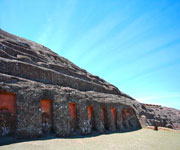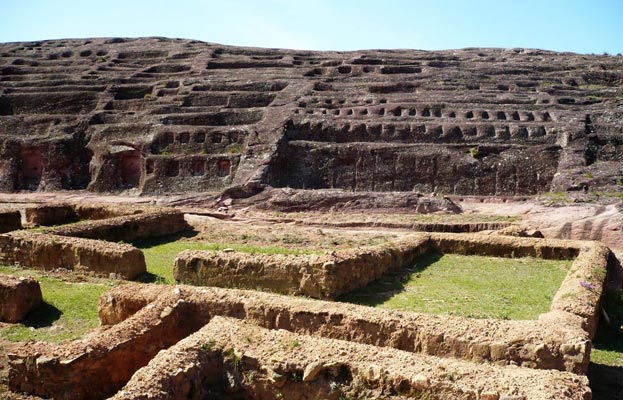Samaipata bears outstanding witness to the existence in this Andean region of a political culture with highly developed religious traditions, illustrated dramatically in the form of the dominant ceremonial feature of this site, its immense rock sculptures. The site is known to have been occupied and used as a ritual and residential centre by people belonging to the Mojocoyas culture as early as AD 300, and it was at this time that work began on the shaping of this great rock. It was occupied in the 14th century by the Inca, who made it a provincial capital. This is confirmed by the features that have been discovered by excavation - a large central plaza with monumental public buildings around it and terracing of the neighbouring hillsides for agriculture - which are characteristic of this type of Inca settlement. It formed a bulwark against the incursions of the warlike Chiriguanos of the Chaco region in the 1520s.

Continent: Southe America
Country: Bolivia
Category: Cultural
Criterion: (II)(III)
Date of Inscription: 1998
Fuerte de Samaipata
The strategic location of the site, which had attracted the Inca to it, was also recognized by the Spaniards. The silver mines of the Cerro Rico at Potosí began to be worked in 1545 and the colonial settlement of Samaipata had become an important staging post on the highway from Asunción and Santa Cruz to the colonial centres in the High Andes such as La Plata (modern Sucre), Cochabamba and Potosí. With the establishment of the new town of Samaipata in the Valle de la Purificación, the ancient settlement had no further military importance and was abandoned.The archaeological site of Samaipata consists of two parts: the hill with its many carvings, believed to have been the ceremonial centre of the old town (14th-16th centuries), and the area to the south of the hill, which formed the administrative and residential district. The reddish sandstone hill is divided naturally into a higher part, known as El Mirador, and a lower, where the carvings are located.
 |
| Fuerte de Samaipata Bolivia |
Browse Gallery Plus UNESCO Storyline
The carvings in the western part include two felines on a circular base, the only examples of high-relief carving in the whole site. The remains of a stone wall of the Inca period cut across a number of the carvings, indicating a pre-Inca date. These include two parallel channels, between and alongside them there are smaller channels cut in zigzag patterns, giving rise to the local name for this feature, El Dorso de la Serpiente.
At the highest point is Coro de los Sacerdotes, which consists of a deeply cut circle with triangular and rectangular niches cut into its walls. Further to the east is a structure which probably represents the head of a feline. Most of the southern face of the rock was originally dominated by a series of at least five temples or sanctuaries, of which only the niches cut into their walls survive. The Casa Colonial is situated on an artificial platform at the foot of the rock. Excavations have revealed evidence of Inca and pre-Inca structures here, and so it is known as the Plaza of the Three Cultures. The house of the colonial period, only the stone lower walls of which survive, is in characteristic Arab-Andalusian style, with a central open courtyard.
Away from the rocky hill, there are a number of isolated small buildings surrounded by perimeter walls, a typical Inca form known as kancha. One of these contains two buildings and another five, arranged in a U-pattern. The main administrative-religious centre of the Inca period is situated on a series of three artificial platforms to the south of the rock. The main feature is an enormous building known as the Kallanka; it is on the lowest platform and faces the ceremonial area on the rock across a spacious plaza.
To the west of the Kallanka and on the second platform is a group of at least twelve large or medium-sized houses, laid out in H-shape, provisionally known as the Akllawasi. These are interpreted as remains of the textiles woven for ritual purposes or exchange by the Virgins of the Sun, whose name akllas is given to this group. On the third platform there is a group of seven Inca houses disposed round an open space on an artificial mound.
Browse All UNESCO World Heritage Sites in
Bolivia. The original UNESCO inscription
Here!!!











No comments:
Post a Comment